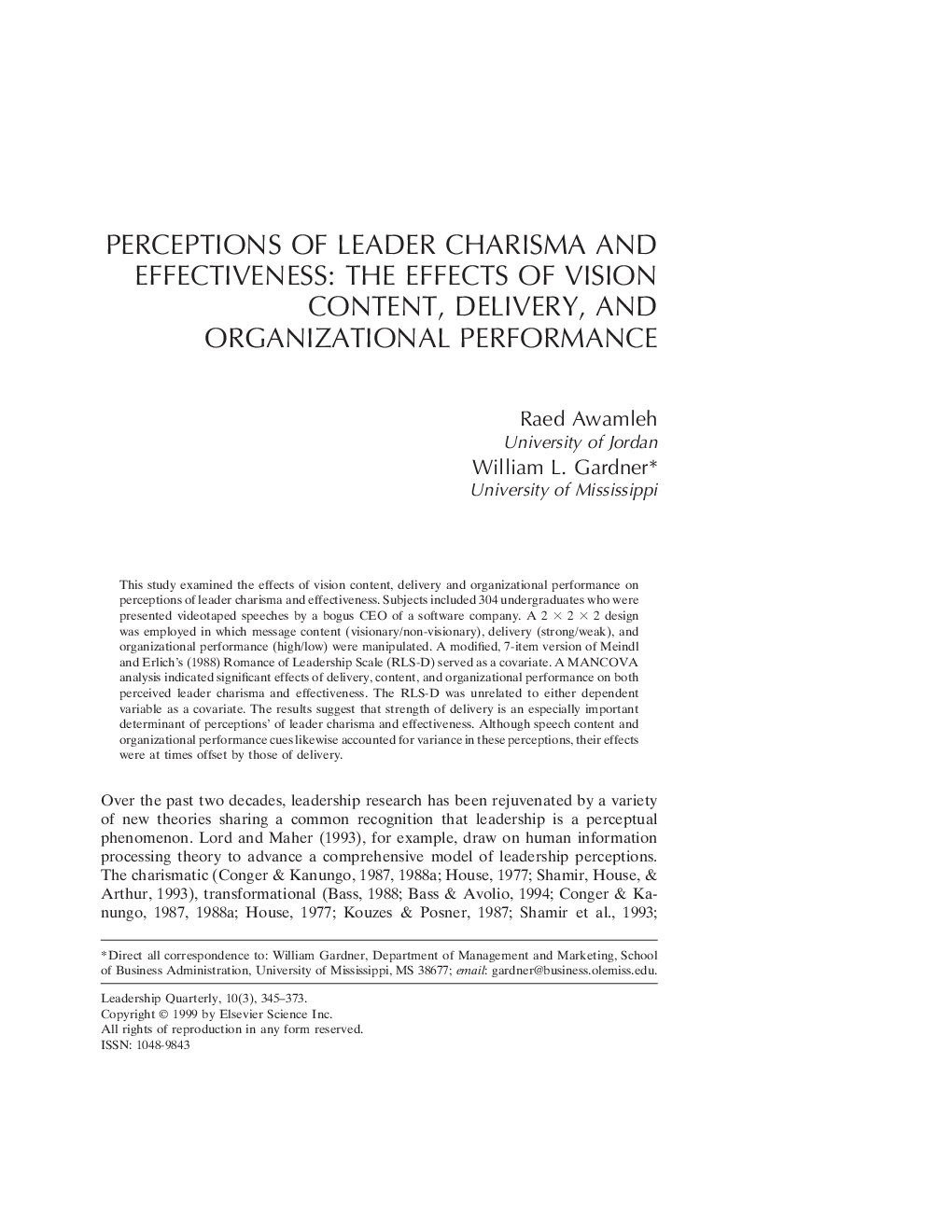برداشت از کاریزمای رهبر و اثربخشی: اثر مقدار چشم انداز، تحویل و عملکرد سازمانی
| کد مقاله | سال انتشار | تعداد صفحات مقاله انگلیسی |
|---|---|---|
| 38231 | 1999 | 26 صفحه PDF |

Publisher : Elsevier - Science Direct (الزویر - ساینس دایرکت)
Journal : The Leadership Quarterly, Volume 10, Issue 3, Autumn 1999, Pages 345–373
چکیده انگلیسی
This study examined the effects of vision content, delivery and organizational performance on perceptions of leader charisma and effectiveness. Subjects included 304 undergraduates who were presented videotaped speeches by a bogus CEO of a software company. A 2 × 2 × 2 design was employed in which message content (visionary/non-visionary), delivery (strong/weak), and organizational performance (high/low) were manipulated. A modified, 7-item version of Meindl and Ehrlich's (1988) Romance of Leadership Scale (RLS-D) served as a covariate. A MANCOVA analysis indicated significant effects of delivery, content, and organizational performance on both perceived leader charisma and effectiveness. The RLS-D was unrelated to either dependent variable as a covariate. The results suggest that strength of delivery is an especially important determinant of perceptions' of leader charisma and effectiveness. Although speech content and organizational performance cues likewise accounted for variance in these perceptions, their effects were at times offset by those of delivery. Over the past two decades, leadership research has been rejuvenated by a variety of new theories sharing a common recognition that leadership is a perceptual phenomenon. Lord and Maher (1993), for example, draw on human information processing theory to advance a comprehensive model of leadership perceptions. The charismatic Conger & Kanungo 1987, Conger & Kanungo 1988a, House 1977 and Shamir et al. 1993, transformational Bass 1988, Bass & Avolio 1994, Conger & Kanungo 1987, Conger & Kanungo 1988a, House 1977, Kouzes & Posner 1987, Shamir et al. 1993 and Tichy & Devanna 1986, and visionary Nanus 1992 and Sashkin 1988 leadership perspectives that Bryman (1992) calls “new leadership” theories, likewise focus on perceptual processes. These theories stress that followers' perceptions are the ultimate determinant of leader influence. More recently, Gardner and Avolio (1998) advanced a dramaturgical perspective of the charismatic relationship which asserts that the leader and followers jointly construct the leader's charismatic image through impression management and impression formation processes. Consensus also exists among new leadership theorists regarding one of the primary sources for charisma: vision. A vision can be defined as a mental image that a leader evokes to portray an idealized future for an organization (Conger, 1989). An idealized vision is generally considered to be a prerequisite for a leader to become transformational or charismatic (e.g., Bass 1990, Conger 1991, Conger & Kanungo 1987 and Tichy & Devanna 1986). Once formulated, this vision must be articulated to mobilize followers to pursue it. Drawing from the communications literature, Holladay and Coombs 1993 and Holladay & Coombs 1994 invoke the concepts of message content and delivery to explain the two-step process whereby charismatic leaders initially craft and then articulate an idealized vision. Surprisingly, empirical efforts to explicate these components are rare. Nevertheless, studies of leader rhetoric Conger 1991, Den Hartog & Verburg 1997 and Shamir et al. 1994 suggest that the leader's choice of words, symbols, and expressions constitute critical content elements which determine the extent to which the audience becomes aroused, inspired, and committed to the vision. Even less research on delivery is available, although more is written about its importance to charisma. Specifically, charismatic leaders are purported to project a powerful, confident, and dynamic presence through the delivery factors of eye contact, fluency, gestures, facial expressiveness, eloquence, energy, and voice tone variety Bass 1985, Bass 1990, Bryman 1992 and Willner 1984. Two studies by Holladay and Coombs 1993 and Holladay & Coombs 1994 suggest that such delivery factors are indeed key determinants of charisma. The current fascination with charisma is not shared by all leadership scholars; to the contrary, some view charisma with a degree of cynicism. Meindl (1990) uses the term “the romance of leadership” to reflect his criticism of both the academic and popular literatures' celebration of leadership as a cure for all or most organizational ills. Attributional theories of leadership (e.g., Calder, 1977) likewise contend that leadership is overvalued, primarily as a result of certain attributional biases. Pre-eminent among these is the fundamental attributional error, which may cause observers, or followers, to overattribute organizational success and failure to leaders, while discounting external factors. Due to the need to make sense of complex organizational environments, people tend to attribute organizational outcomes to leaders (Meindl, Ehrlich, & Dukerich, 1985), especially when exposed to extreme situations, such as very high or low performance. Viewed from this perspective, the commonly assumed direction of the leadership–performance relationship is backwards; instead, organizational performance is seen as a cause, rather than a consequence, of charismatic leadership. According to Meindl (1990), some individuals exhibit a dispositional tendency to attribute organizational outcomes to leadership across situations. Such individuals are especially inclined to attribute leadership and charisma to persons who appear to be, or claim to be, responsible for organizational outcomes (Shamir, 1992), even if such inferences are unwarranted. Overall, these attributionally based explanations of leadership question the importance of leader behavior in inducing perceptions of leadership, while casting doubts upon the relationship between real leader performance and leadership perceptions. The above discussion suggests an agenda for research to clarify these issues. In particular, the joint effects of vision content, delivery, organizational performance cues, and generalized leadership beliefs on perceived charisma and leader effectiveness warrant empirical attention. Accordingly, the present study proceeded with three key objectives in mind: (1) to explore the combined effects of vision content and delivery on perceptions of leader charisma and effectiveness; (2) to investigate the relative effects of performance outcomes on these perceptions; and (3) to examine the effects of generalized beliefs about leadership (i.e., romance of leadership disposition) on leadership perceptions.

